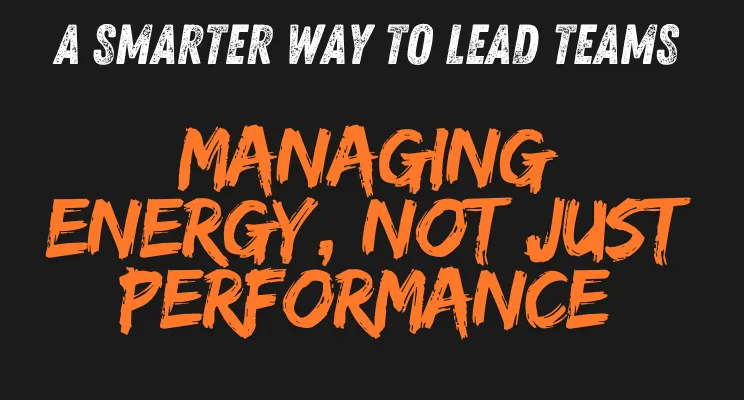
A Smarter Way to Lead Teams Managing Energy, Not Just Performance
If you’ve ever looked at your team and thought, “We’ve got the skills, the goals, and the strategy so why are we still dragging?” the answer may have nothing to do with capability and everything to do with energy.
I’ve worked with high-performing teams across corporate, family-run businesses, and leadership retreats, and I see the same pattern repeat itself: great people burning out inside great plans. Not because the vision was wrong, but because no one was monitoring the actual energy that fuels execution.
We obsess over KPIs, OKRs, deadlines, dashboards… but very few leaders are asking the more critical question:
What’s the emotional battery status of the people I’m expecting to perform at a high level?
The truth is, people don’t quit businesses they quit emotional exhaustion. And performance without energy is unsustainable. It looks good for a quarter, and then things start to unravel morale dips, conflict spikes, creativity flatlines.
The smartest leaders I know aren’t just performance-driven. They’re energy-aware.
Why Managing Performance Alone Is Outdated
Let’s start with what we all know: performance metrics matter. They show us results. They hold people accountable. They give structure to expectations.
But here’s where it goes sideways: when performance is the only thing being measured, you stop seeing your team as human beings with capacity limits and start treating them like machines.
According to Deloitte’s 2024 Global Human Capital Trends report, nearly 60% of employees say their workplace treats productivity as more important than well-being and over half report it’s why they consider leaving.
In other words, the problem isn’t lack of clarity or vision. It’s energy bankruptcy and most teams are living in it silently.
This is especially true in South African business environments where the pressure to “show up strong” is embedded in many leadership cultures. We’re not taught to pause. We’re taught to push.
But burnout isn’t a personal failure. It’s a systemic leadership oversight.
Energy Management: What It Looks Like in Real Teams
Managing energy doesn’t mean coddling your team or lowering standards. It means you’re smart enough to realise that no one performs at a high level with an empty tank.
It also means paying attention to:
Rhythm: Is your team always in sprint mode? High-performers can handle pressure but they need cycles. Think of it like interval training. Sprint. Breathe. Reset. Repeat.
Emotional load: Is there unspoken tension on your team? Emotional labour (conflict, fear, uncertainty) drains capacity even if performance metrics haven’t dipped yet.
Autonomy: Are people allowed to structure their time based on peak energy? If you expect focus at 8 a.m. but your team thrives mid-morning, you’re fighting biology, not just preference.
Something I recently implemented with my team: Mondays we have weekly check-in meeting (WCM) (emotional clarity, feedback loops and outline tasks for the week). This is not micromanagement but accountability system. The result? More sustainable momentum and a team that didn’t dread Mondays.
What You Can Do as a Leader Today
1. Normalise energy conversations.
Ask your team what drains them not just what delays them. Start with “What’s your energy level this week?” as a check-in opener. It sounds simple. It changes everything.
2. Audit your week.
Look at your team calendar. Are people spending more time in meetings than in flow? Do they have recovery windows between high-stress sprints? Build rest into the workflow.
3. Protect meaning, not just minutes.
Performance is not just about time spent. It’s about clarity and alignment. Ensure your team understands why they’re doing the work. People are less drained when they believe in what they’re building.
4. Lead by energy, not emotion.
You don’t have to be “positive” all the time. But you do have to model emotional regulation. If you show up overwhelmed, anxious, or reactive you’re transmitting stress more than strategy.
From Push to Pulse: A Smarter Leadership Move
When you lead by performance only, you drive short-term results.
When you lead by performance and energy, you build resilient systems.
This isn’t theory it’s business strategy. The top companies in the world are now investing in energy-awareness training, coaching for resilience, and emotional intelligence programs. Why? Because performance is no longer about how much people can do. It’s about how long they can keep doing it well.
If you want a team that can scale, innovate, and sustain growth stop asking, “What’s the output?” and start asking:
“Do we have the energy to keep going?”
That’s where performance becomes sustainable.
That’s where culture gets healthier.
That’s where leaders actually lead.
